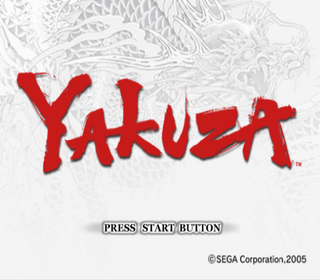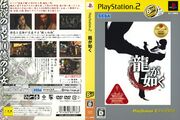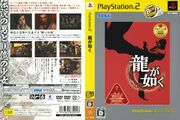Difference between revisions of "Yakuza"
From Sega Retro
m |
AllisonKidd (talk | contribs) m (→Physical Scans) |
||
| Line 112: | Line 112: | ||
| psm=85 | | psm=85 | ||
| psm_source=''October 2006, p72'' | | psm_source=''October 2006, p72'' | ||
| − | |||
| − | |||
| ugo=91 | | ugo=91 | ||
| ugo_source=''[http://web.archive.org/web/20110615063308/www.ugo.com/ugo/html/article/?id=15307§ionId=28 UGO]'' | | ugo_source=''[http://web.archive.org/web/20110615063308/www.ugo.com/ugo/html/article/?id=15307§ionId=28 UGO]'' | ||
Revision as of 21:43, 9 October 2015
| Yakuza | ||||||||||||||||||||||||||||||||||||||||
|---|---|---|---|---|---|---|---|---|---|---|---|---|---|---|---|---|---|---|---|---|---|---|---|---|---|---|---|---|---|---|---|---|---|---|---|---|---|---|---|---|
| System(s): PlayStation 2 | ||||||||||||||||||||||||||||||||||||||||
| Publisher: Sega | ||||||||||||||||||||||||||||||||||||||||
| Developer: New Entertainment R&D Dept. #1 | ||||||||||||||||||||||||||||||||||||||||
| Genre: Action | ||||||||||||||||||||||||||||||||||||||||
| Number of players: 1 | ||||||||||||||||||||||||||||||||||||||||
| ||||||||||||||||||||||||||||||||||||||||
|
CERO
Missing Parameter! |
This short article is in need of work. You can help Sega Retro by adding to it.
Yakuza, known as Ryu ga Gotoku (龍が如く) in Japan, is an open world action game developed by New Entertainment R&D Dept. #1 and published by Sega for the PlayStation 2 in 2005. It marks the start of the Yakuza series, a set of successful first party games centered around the world of Japanese organised crime.
Though not directly related, Yakuza is often seen as a spiritual successor (and lower budget alternative) to Shenmue. It was produced by Toshihiro Nagoshi of Super Monkey Ball and Sega AM2/Amusement Vision fame. During development the project was known as Project J.
Contents
Story
Taking place in 1995 in Kamoro-cho, a fictional district in Tokyo (which modelled after Shinjuku) story follows Kazuma Kiryu, a young Yakuza working under Dojima Family of Tojo Clan, a powerful Yakuza organization in the Kanto area of Japan. Kiryu's life changes irreversibly when one day his love interest Yumi is kidnapped by Dojima, leader of the family Kiryu is serving. His close friend Akira Nishikiyama attempts to save Yumi from Dojima and ends up killing him. Kiryu decides to take the blame for killing (Nishkiyama's sister is in deathbed) and spends 10 years in prison for murder.
In prison, Kiryu receives a letter of ex-communication and removed from Tojo Clan. Although he is visited by Shintaro Kazama, his adopter father who is also a Yakuza leader, he doesn't hear anything from either Yumi or Nishikiyama.
Eventually released in 2005, Kiryu attempts to bring his life together and find Yumi. On the way, he meets Haruka, a mysterious little girl. After being targeted by Yakuza families all around the Tokyo for "10 billion Yen" and realizing that Haruka could be the key to finding Yumi, Kiryu takes Haruka under his protection and resolves to solve the mystery.
History
Legacy
Much like Shenmue before it, Yakuza became a substantial success in Japan but failed to convince Western consumers upon release, despite a large marketing campaign and mostly positive reaction from gaming community. The Japanese version was re-released as part of the PlayStation 2 the Best" budget range on 26 October 2006 for ¥1,800 (1,890 inc. tax), and has since been remastered as part of 2012's Ryu ga Gotoku 1&2 HD Edition for the PlayStation 3 (and later Wii U).
The game was initially dubbed into English for North American audiences, however criticism with the English voice acting prompted Sega to keep the Japanese voiceover in subsequent overseas releases.
Yakuza was followed by a range of sequels (starting with Yakuza 2 in 2006), as well as spin-offs and two live-action films. Lukewarm sales in Western regions led to Sega developing a steadily declining appetite for overseas Yakuza games - Yakuza 2 was delayed by two years, and 2008's spin-off, Ryu ga Gotoku Kenzan! was not released in Western regions at all.
A soundtrack album for the first two games, Ryu ga Gotoku & Ryu ga Gotoku 2 Original Sound Track, was released on 25 January 2007.
Artwork
- Yakuza date bust.jpg
- Yakuza haruka bust.jpg
- Yakuza kazama bust.jpg
- Yakuza reina bust.jpg
- Yakuza sera bust.jpg
- Yakuza yumi bust.jpg
- Yakuza yumi bust02.jpg
- Yakuza haruka.jpg
- Yakuza kiryu dragon.jpg
- Yakuza nishiki koi.jpg
- Yakuza nishikiyama.jpg
- Yakuza tattoo dragon.jpg
Promotional Material
Physical Scans
| Sega Retro Average | |||||||||||||||||||||||||||||
|---|---|---|---|---|---|---|---|---|---|---|---|---|---|---|---|---|---|---|---|---|---|---|---|---|---|---|---|---|---|
|
| 82 | |
|---|---|
| Based on 5 reviews | |
External Links
- Sega of Japan catalogue pages (Japanese): PlayStation 2
- SCEJ catalogue pages (Japanese): PlayStation 2
- Official website (Japanese)
- Official website on Sega.com
- ↑ Electronic Gaming Monthly, "October 2006" (US; 2006-09-12), page 112
- ↑ Famitsu, "2005-12-16" (JP; 2005-12-02), page 1
- ↑ GameCentral (UK) (+0:00)
- ↑ GamePro, "October 2006" (US; 2006-09-12), page 81
- ↑ Hyper, "September 2006" (AU; 2006-08-09), page 46
- Pages with broken file links
- 1 player games
- JP PlayStation 2 games
- All JP games
- US PlayStation 2 games
- All US games
- EU PlayStation 2 games
- All EU games
- AU PlayStation 2 games
- All AU games
- KR PlayStation 2 games
- All KR games
- All action games
- PlayStation 2 games
- All 2005 games
- 2005 PlayStation 2 games
- Old content rating field
- All games
- Stubs
- Old-style rating (dengekips)
- Rating without source
- Old-style rating (edge)
- Old-style rating (egm)
- Old-style rating (famitsu)
- External rating reference
- Old-style rating (famitsucom)
- Old-style rating (gaf)
- Old-style rating (gamepro)
- Old-style rating (gamesmaster)
- Old-style rating (gamestm)
- Old-style rating (play)
- Old-style rating (psm)
- Old-style rating (ugo)
- Update ratings template
- 12 old ratings
- Yakuza (franchise)




















